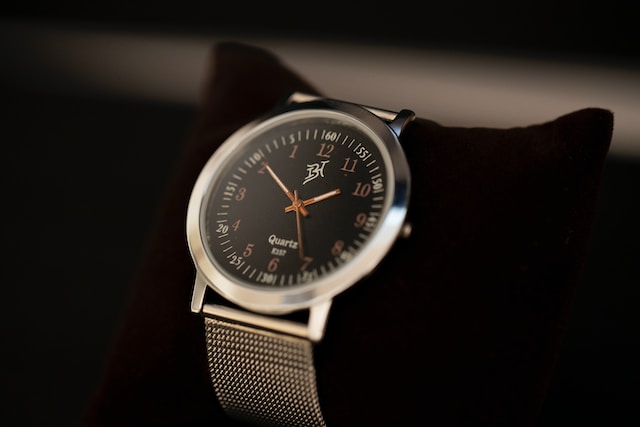In the world of luxury timepieces, a select few stand out not just for their precision but for their staggering price tags and extraordinary craftsmanship. These watches transcend the realm of mere timekeeping to become masterpieces of horological art and exclusivity. Here’s a closer look at the top 10 most expensive watches in the world and the reasons behind their phenomenal prices.
10 Most Expensive Watches In The World
| No | Most Expensive Watches | Price |
| 1 | Graff Diamonds Hallucination | $55 million |
| 2 | Graff Diamonds The Fascination | $40 million |
| 3 | Patek Philippe Grandmaster Chime Ref. 6300A-010 | $31 million |
| 4 | Breguet Grande Complication Marie Antoinette | $30 million |
| 5 | Jaeger-LeCoultre Joaillerie 101 Manchette |
$26 million
|
| 6 | Patek Philippe Henry Graves Supercomplication |
$26 million
|
| 7 | Chopard 201-Carat | $25 million |
| 8 | Rolex Paul Newman Daytona Ref. 6239 | $18.7 million |
| 9 | Jacob & Co. Billionaire Watch | $18 million |
| 10 | Patek Philippe Stainless Steel Ref. 1518 | $12 million |
Graff Diamonds Hallucination
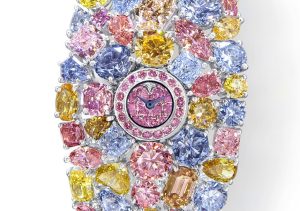
Overview: Graff Diamonds Hallucination is the most expensive watch in the world. The Graff Diamonds Hallucination holds the crown as the most expensive watch globally. This opulent timepiece is adorned with an astonishing array of rare and vibrant colored diamonds, totaling over 110 carats. The Hallucination is a kaleidoscope of brilliance with diamonds in shades of pink, blue, green, and yellow.
Why It’s So Expensive:
- Diamond Quality: The Hallucination features some of the rarest and most valuable diamonds in the world.
- Exclusivity: Each diamond is meticulously set by hand, creating a unique and dazzling spectacle.
- Artistry and Craftsmanship: The intricate setting and design showcase Graff’s exceptional skill in combining haute horlogerie with high jewelry.
Graff Diamonds The Fascination
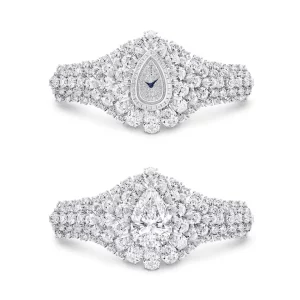
Overview: Graff Diamonds The Fascination is the 2nd most expensive watch in the world. The Fascination by Graff Diamonds is a remarkable piece that combines high jewelry with horology. It features a detachable pear-shaped diamond that can be worn as a ring. The surrounding bracelet is encrusted with marquise and brilliant-cut diamonds.
Why It’s So Expensive:
- Versatility: The detachable diamond adds an element of functionality and luxury.
- Craftsmanship: Meticulous arrangement of diamonds enhances its elegance and innovation.
- Brand Prestige: Graff’s reputation for excellence in both jewelry and watches contributes to its high value.
Patek Philippe Grandmaster Chime Ref. 6300A-010
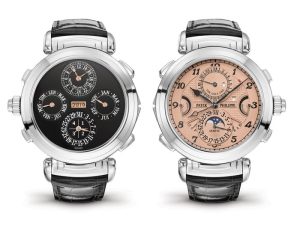
Overview: Patek Philippe Grandmaster Chime Ref. 6300A-010 is the 3rd most expensive watch in the world. The Grandmaster Chime Ref. 6300A-010 is a masterpiece of Patek Philippe, crafted in stainless steel. This watch features two dials and a staggering 20 complications, including a perpetual calendar, moon phase display, and minute repeater.
Why It’s So Expensive:
- Complexity: Its 20 complications showcase advanced horological craftsmanship.
- Material and Design: Stainless steel adds rarity, and the dual-dial design is both functional and visually stunning.
- Patek Philippe’s Legacy: The brand’s reputation for creating intricate and prestigious timepieces elevates its value.
Breguet Grande Complication Marie Antoinette
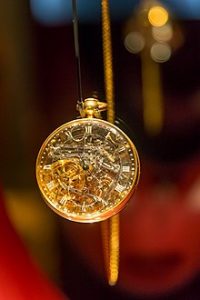
Overview: Breguet Grande Complication Marie Antoinette is the 4th most expensive watch in the world.The Breguet Grande Complication Marie Antoinette is a historical masterpiece commissioned in the 18th century. This watch features numerous complications, including a minute repeater, perpetual calendar, and tourbillon, housed in an exquisitely engraved case.
Why It’s So Expensive:
- Historical Significance: Its connection to Marie Antoinette adds historical value.
- Complications: The inclusion of various horological complications demonstrates advanced craftsmanship.
- Craftsmanship: Intricate engravings and high-quality materials contribute to its price.
Jaeger-LeCoultre Joaillerie 101 Manchette
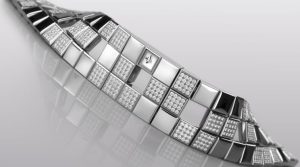
Overview: Jaeger-LeCoultre Joaillerie 101 Manchette is the 5th most expensive watch in the world. The Joaillerie 101 Manchette by Jaeger-LeCoultre is a stunning blend of horological engineering and jewelry artistry. It features a bracelet covered in meticulously set diamonds and the Caliber 101, one of the smallest mechanical movements in the world.
Why It’s So Expensive:
- Mechanical Ingenuity: The Caliber 101 movement is a technical marvel.
- High Jewelry: The diamond-encrusted bracelet showcases exceptional jewelry craftsmanship.
- Limited Production: Its exclusivity and intricate design contribute to its high price.
Patek Philippe Henry Graves Supercomplication
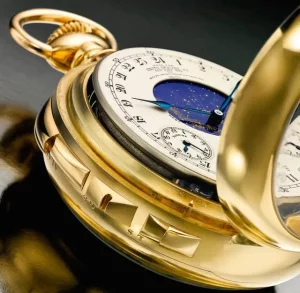
Overview: Patek Philippe Henry Graves Supercomplication is the 6th most expensive watch in the world. The Patek Philippe Henry Graves Supercomplication is a legendary pocket watch with 24 complications, including a perpetual calendar and celestial chart. Created in 1925 for banker Henry Graves Jr., it remains one of the most intricate watches ever made.
Why It’s So Expensive:
- Complexity: The 24 complications represent a high level of horological skill.
- Historical Value: Its provenance and the story behind its creation add to its value.
- Craftsmanship: Patek Philippe’s attention to detail and quality materials contribute to its high price.
Chopard 201-Carat
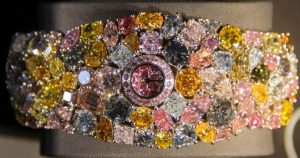
Overview: Chopard 201-Carat is the 7th most expensive watch in the world. The Chopard 201-Carat is an extravagant timepiece adorned with 201 carats of diamonds. The watch features a blend of colored diamonds that create a mesmerizing effect.
Why It’s So Expensive:
- Diamond Weight: The sheer number and size of diamonds make it a dazzling spectacle.
- Artistry: The creative use of diamonds and craftsmanship elevate its value.
- Brand Legacy: Chopard’s reputation for luxury and quality enhances its exclusivity.
Rolex Paul Newman Daytona Ref. 6239
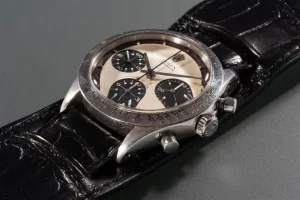
Overview: Rolex Paul Newman Daytona Ref. 6239 is the 8th most expensive watch in the world. The Rolex Paul Newman Daytona Ref. 6239 is an iconic timepiece known for its distinctive “exotic” dial. Named after the famous actor and racing driver Paul Newman, this watch is a coveted collector’s item.
Why It’s So Expensive:
- Historical Significance: Paul Newman’s association with the watch adds to its appeal.
- Rarity: Limited production and unique design make it highly sought after.
- Condition and Provenance: The watch’s condition and historical background drive its high value.
Jacob & Co. Billionaire Watch
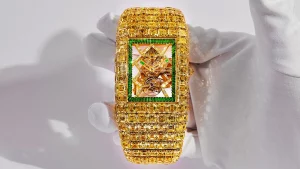
Overview: Jacob & Co. Billionaire Watch is the 9th most expensive watch in the world. The Jacob & Co. Billionaire Watch is a bold statement of opulence, featuring over 260 carats of diamonds covering the entire watch. Its design is both extravagant and meticulously crafted.
Why It’s So Expensive:
- Diamond Coverage: The extensive use of diamonds enhances its luxury.
- Design and Craftsmanship: The watch’s bold design and expert craftsmanship contribute to its price.
- Exclusivity: Its unique design and high carat weight make it a rare and valuable piece.
Patek Philippe Stainless Steel Ref. 1518
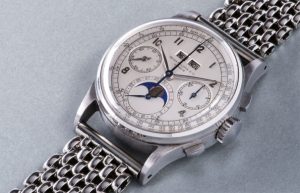
Overview: Patek Philippe Stainless Steel Ref. 1518 is the 10th most expensive watch in the world. The Patek Philippe Ref. 1518 is a historic wristwatch known for being the first serially produced perpetual calendar chronograph. Its stainless steel case makes it highly collectible and rare.
Why It’s So Expensive:
- Historical Innovation: It represents a significant achievement in watchmaking history.
- Material Rarity: The stainless steel case adds to its exclusivity.
- Collector’s Value: Its rarity and historical significance contribute to its high price.
Frequently Asked Questions
How much are rolex watches?
Rolex watches encompass a wide range of models and prices, making them accessible to various budgets and preferences. Entry-level Rolex watches, such as the Oyster Perpetual line, typically start around $5,000 to $6,000. The iconic Rolex Submariner and Rolex Datejust models can range from approximately $8,000 to $12,000, depending on the specific variation and materials.
As you venture into Rolex’s more intricate and luxurious offerings, such as the Daytona, GMT-Master II, or Day-Date, prices can escalate significantly, often exceeding $20,000 and reaching well into the six-figure range for rare or vintage models. Ultimately, the price of a Rolex watch is determined by factors like model, materials, rarity, and demand.
How long do Apple watches last?
Apple watches are designed to provide reliable performance and longevity. On average, an Apple watch can last for about three to four years before it may start experiencing hardware or battery-related issues.
However, with proper care and maintenance, some users have reported their Apple watches functioning well beyond the four-year mark. The lifespan of an Apple watch can be influenced by factors such as usage patterns, battery charging habits, software updates, and overall care. Apple’s commitment to ongoing software support also ensures that older watch models continue to receive software updates, enhancing their functionality and extending their usability.
When were watches invented?
Watches have a rich and fascinating history, with their origins dating back to ancient times. The invention of mechanical timekeeping devices can be traced to the 14th century, with the introduction of spring-driven clocks. However, it wasn’t until the 16th century that watches, as we know them today, began to emerge.
Pioneering watchmakers like Peter Henlein of Germany played a crucial role in miniaturizing clocks and creating portable timepieces that could be worn on the wrist. Over the centuries, watchmaking techniques advanced, leading to the development of more accurate and intricate watches. Today watches continue to evolve, combining traditional craftsmanship with modern technology to serve as both functional timekeepers and stylish accessories.
Where are rolex watches made?
Rolex watches are known for their exceptional quality and precision, and their production is carried out entirely in-house. The brand has its headquarters and manufacturing facilities in Geneva, Switzerland.
Every aspect of creating a Rolex watch, from the design and engineering to the crafting of individual components and the assembly of the final timepiece, takes place within Rolex’s workshops. Rolex meticulously controls the entire manufacturing process, ensuring that each watch meets its stringent standards of excellence. This vertical integration allows Rolex to maintain strict quality control and preserve the brand’s reputation for producing some of the finest and most coveted timepieces in the world.
Which Apple watches are waterproof?
Apple offers several waterproof or water-resistant models within its Apple Watch lineup. Starting from the Series 2, all subsequent models, including the Series 3, Series 4, Series 5, Series 6, and the latest Apple Watch Series 7, have been designed with water resistance capabilities. These watches are built to withstand water exposure during various activities like swimming and water sports.
While the specific water resistance ratings may vary between models, they generally offer a minimum of 50 meters (164 feet) of water resistance, allowing users to track their workouts in the pool or engage in water-related activities with peace of mind.
How do automatic watches work?
Automatic watches, also known as self-winding watches, harness the power of motion to keep time. Inside these timepieces, a small rotor moves with the natural movements of the wearer’s wrist, transferring energy to the mainspring. The mainspring stores this energy and gradually releases it to power the watch’s mechanism.
As the mainspring unwinds, it drives the gears, hands, and complications, regulating the movement of the watch. This mechanical process is aided by an escapement mechanism, which controls the release of energy in precise increments, ensuring accurate timekeeping.
Thanks to their ingenious design, automatic watches provide a convenient and reliable timekeeping experience without the need for manual winding.
Why are watches so expensive?
Watches can be expensive due to various factors. First, high-end watches often feature intricate craftsmanship, with skilled artisans dedicating hours of labor to meticulously hand-assemble and finish each timepiece.
The use of premium materials, such as precious metals and gemstones, further adds to the cost. Additionally, brands invest heavily in research and development to create innovative movements and complications, driving up prices. Limited production numbers, exclusivity, and the reputation of luxury brands also contribute to higher prices.
Furthermore, the prestige and heritage associated with luxury watches make them highly sought-after, allowing brands to command a premium in the market.
Where are Bulova watches made?
Bulova watches are proudly made in various locations, combining a rich history of American craftsmanship with global manufacturing capabilities. While the brand’s roots are in the United States, with the company originally founded in New York City in 1875, Bulova’s production expanded to include manufacturing facilities in Switzerland and Asia.
The brand continues to design and assemble watches in its headquarters in New York City, ensuring that the spirit and heritage of Bulova remain integral to its timepieces. This blend of American heritage and international manufacturing expertise allows Bulova to offer a diverse range of high-quality watches that cater to different tastes and styles.
How much do Apple watches cost?
Apple watches come in various models and configurations, offering options at different price points to cater to diverse consumer preferences. The cost of Apple watches depends on factors such as the series, case material, size, connectivity (GPS or GPS + Cellular), and additional features.
Entry-level models, like the Apple Watch SE, start around $279, while the latest flagship models, such as the Apple Watch Series 7, can range from approximately $399 and upwards depending on the chosen specifications.
Special editions or versions with premium materials like stainless steel or Hermès collaborations may have higher price tags. Ultimately, the price of an Apple watch allows customers to select a model that best suits their needs and budget.
Where to sell watches?
When it comes to selling watches, there are several avenues to explore. One option is to visit reputable watch dealers or luxury watch boutiques that specialize in buying pre-owned timepieces. These establishments have the expertise to evaluate the value of your watch and make you a competitive offer.
Online platforms dedicated to buying and selling watches, such as Chrono24 or WatchBox, provide convenient and accessible options.
Additionally, you can consider selling through online marketplaces like eBay or classified ads in local publications. Whichever method you choose, it’s advisable to research and compare offers to ensure a fair and satisfactory transaction.
Where to buy watches?
When looking to purchase watches, there are numerous options available to suit different preferences and budgets. High-end watch boutiques and authorized dealers offer an immersive experience, providing access to a wide range of luxury brands and personalized service.
Department stores often have dedicated watch sections featuring popular brands. Online retailers like Amazon, Jomashop, and WatchMaxx provide a convenient platform to browse and purchase watches from various brands and price ranges.
Auctions, both online and in-person, offer a chance to find unique and collectible timepieces. Additionally, pre-owned watch marketplaces such as Chrono24 and WatchBox offer an array of options for purchasing pre-owned watches with authenticity guarantees.
How do watches work?
Watches work through a combination of mechanical or electronic components that enable accurate timekeeping. Mechanical watches rely on the intricate movements of gears, springs, and an oscillating balance wheel regulated by an escapement mechanism.
As the mainspring unwinds, it releases stored energy that powers the gears, hands, and complications. Electronic watches, including quartz watches, use a battery to send electricity through a quartz crystal, which vibrates at a precise frequency.
These vibrations are converted into regular electrical pulses that drive the watch’s hands. Both types of watches are calibrated to ensure accurate timekeeping, allowing us to keep track of the hours, minutes, and seconds with reliability.

